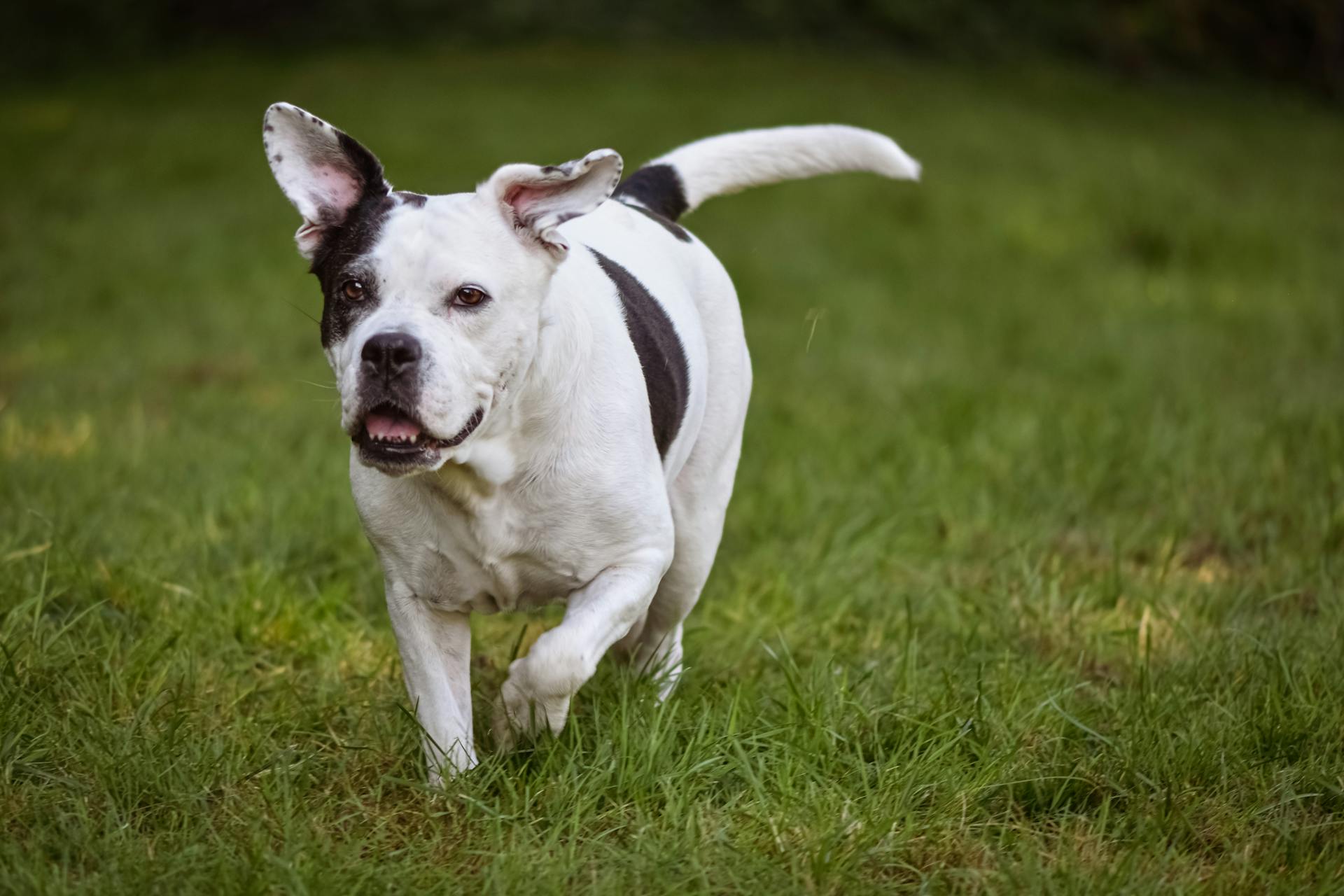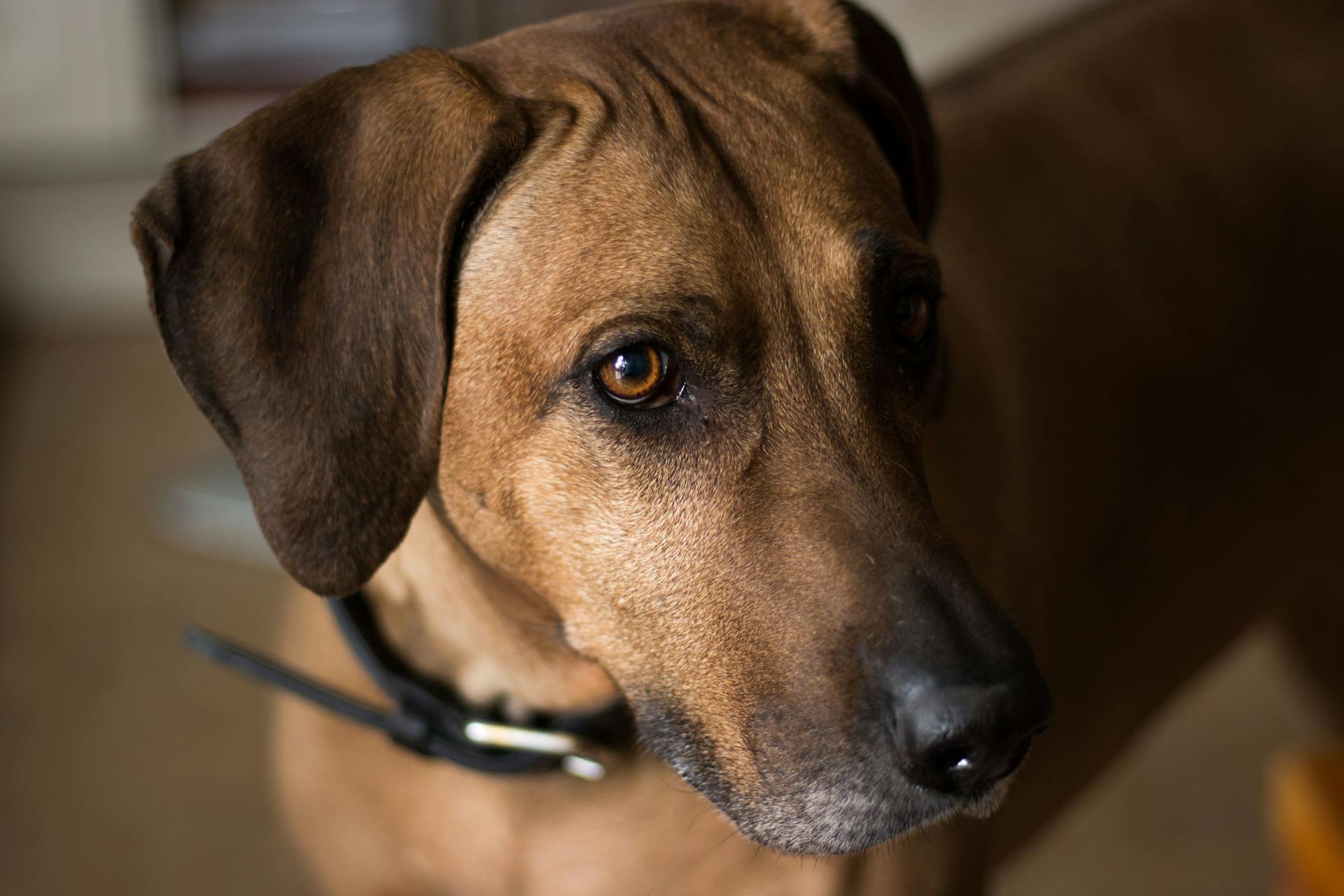
Welcoming a Patterdale Terrier puppy into your life is a thrilling experience, but it's essential to be prepared for the challenges and joys that come with it.
Patterdale Terrier puppies are born after a gestation period of around 60-62 days. Their eyes and ears are closed at birth, but they begin to open around 10-14 days old.
Puppies start teething around 3-4 weeks old, which can be a challenging time for both the puppy and their owner. To ease the discomfort, provide plenty of chew toys and keep an eye on their teething progress.
Patterdale Terrier puppies are naturally curious and love to explore their surroundings, which can sometimes get them into trouble. Supervise them closely during this period to ensure their safety.
History
The Patterdale Terrier has a rich history that dates back to the rugged Lakes Region of Northern England. The breed originated from the fell terrier group, which includes the Lakeland Terrier and the Scorrier Terrier.
These tough little dogs were bred to hunt foxes that threatened the flocks of sheep, and they were known for their ability to flush foxes from their rocky dens or quickly dispatch them if they put up a fight. Originally, they were developed in the harsh climate of Northern England, where they had to withstand extreme weather conditions.
The breed was first developed by Joe Bowman, Master of the Ullswater Hunt, who combined the blue-black Border Terriers with Black and Tan Fell terriers to create his ideal 'go anywhere, all purpose' terrier. Later, Cyril Breay and Frank Buck continued his work, refining the breed to produce a useful working terrier.
Today, the Patterdale Terrier is recognized by several kennel clubs, including the United Kennel Club, which recognized the breed in 1995. The breed is also recognized by the ACA, ACR, APRI, CKC, DRA, and NKC.
Here are some key characteristics of the breed's history:
The Patterdale Terrier's ability to adapt to extreme weather conditions and its fearless and lively personality make it a popular breed among hunters and pet owners alike.
Breed Characteristics
Patterdale Terrier puppies are usually born in litter sizes of 2-5, although mothers may produce one or two more per litter.
Their price averages between $500-$700 USD, and they're ready to go to their new home from eight weeks old.
Patterdale puppies reach their adult size at around 10 months, and are normally fully mature between 14 months to 16 months.
They're small dogs, with an average weight of 15-35 pounds and a height of 9-15 inches.
Here's an interesting read: Border Terrier Litter
Characteristics
Patterdale Terriers are born in litter sizes of 2-5, although mothers may produce one or two more per litter.
The average price of a Patterdale Terrier puppy is between $500-$700 USD.
Patterdale puppies are usually ready to go to their home from eight weeks old.
They reach their adult size at around 10 months and are normally fully mature between 14 months to 16 months.
These little dogs are small, with an average weight of 15-35 pounds and a height of 9-15 inches.
Their short, dense coat comes in a variety of colors, including black, red, brown, and pied.
Patterdale Terriers have a relatively low-maintenance coat that only needs to be brushed once a week to remove loose hair and distribute skin oils.
Check this out: Smooth Haired Fox Terrier Puppies
Coat and Colour
The Patterdale Terrier's coat is one of its most distinctive features. It comes in three types: smooth, broken, and rough.
The smooth coat is short, glossy, and has a dense undercoat that doesn't require much grooming. Regular brushing can help control shedding.
A broken coat has coarse, wiry guard hairs that are longer than the smooth coat type's, and may have facial furnishings like a beard, mustache, and eyebrows.
The rough coat is coarse and longer than the other coat types, and always has furnishings.
Patterdale Terriers can be solid or have white markings on the chest and feet. Their standard coat colors include black, red, chocolate, grizzle, black and tan, and bronze.
Here are the three coat types in more detail:
- Smooth coat: short and shiny
- Broken coat: coarse with longer hair around the face and chin
- Rough coat: longer hair all over with a thick double coat
While this breed is not an ideal choice for allergy sufferers, their coat is very easy to care for. A good brush per week should keep them in tip top shape.
Temperament and Personality
Patterdale Terrier puppies tend to be bold and confident beyond their capabilities, making them a handful to handle.
They have a high prey drive, which means they'll need to be walked on a leash or in a secured garden to prevent them from chasing after small animals.
Patterdales are very energetic and can be difficult to socialize, so it's essential to start training them from an early age to prevent behavioral issues.
They live for the opportunity to hunt, and killing small furry animals is in their blood, so they'll need plenty of exercise and mental stimulation to keep them happy.
Patterdale Terriers are prone to separation anxiety and may be destructive if left alone for long periods, so it's crucial to provide them with plenty of attention and interaction.
They require a secure, fenced yard to keep them safe and prevent them from escaping or chasing after neighborhood critters.
Discover more: Small Yorkshire Terrier
Patterdales are very willful, so positive reinforcement is the recommended route to take when it comes to training, and short training sessions are best to keep them from losing interest.
They need early socialization, exposure to many different people, sights, sounds, and experiences, to grow up to be a well-rounded dog.
Patterdale Terriers are excellent companions for experienced pet parents looking for a high-energy sidekick, but they may not be a good fit for homes with other small pets due to their strong prey drive.
Health and Care
As a new Patterdale Terrier puppy owner, it's essential to be aware of some potential health issues that may arise. Patterdale Terriers can be prone to dry skin, so regular grooming and monitoring for signs of dryness, such as flakiness or irritation, is crucial.
Regular veterinary checkups are also vital to detect any health concerns early, such as lens luxation, a serious eye condition that can cause vision loss and other complications. Your vet can help you develop a care routine to prevent or address these issues.
Some common health problems in Patterdale Terriers include hip dysplasia, a condition where the hip joint doesn't develop properly, and intervertebral disc disease (IVDD), which can cause pain and neurological symptoms. To prevent these conditions, maintain your dog's ideal weight through regular exercise and a balanced diet.
To ensure your Patterdale Terrier stays healthy, make sure to:
- Provide regular exercise, including at least one 30-minute to 1-hour walk per day
- Check and clean their ears regularly to prevent infections
- Trim their nails regularly to prevent overgrowth
- Brush their teeth regularly to prevent dental issues
By following these simple care tips and being aware of potential health issues, you can help your Patterdale Terrier puppy live a happy, healthy life.
Health
Patterdale Terriers are generally sturdy and healthy dogs, but like any breed, they can be prone to certain health issues. Primary Lens Luxation is a condition where the fibers that support the lens of the eye disintegrate, causing the lens to fall out of its position.
Some Patterdale Terriers may experience knee problems, specifically Patellar Luxation, where the kneecap slips out of place. This can require surgery if it happens repeatedly.
Dry skin, also known as canine dry skin or xerosis, is a common condition that can cause discomfort and irritation for Patterdale Terriers. Several factors can contribute to dry skin in dogs, and it's essential to address the underlying causes and provide appropriate care.
Lens Luxation is a serious eye condition where the lens dislocates from its normal position within the eye, which can have severe consequences for a dog's vision and overall eye health.
Patterdale Terriers can also be affected by Intervertebral Disc Disease (IVDD), a spinal condition that occurs when the intervertebral discs degenerate or herniate, putting pressure on the spinal cord.
Here are some common health issues that can affect Patterdale Terriers:
- Primary Lens Luxation
- Patellar Luxation
- Dry Skin
- Lens Luxation
- Intervertebral Disc Disease (IVDD)
Hypothyroidism, a common endocrine disorder, can occur in Patterdale Terriers when the thyroid gland doesn't produce enough thyroid hormones. These hormones play a crucial role in regulating a dog's metabolism.
Hip Dysplasia is a condition where the hip joint doesn't develop properly, characterized by a loose and poorly fitting ball-and-socket joint in the hip.
Nutrition

Patterdale Terriers need a well-balanced diet to stay in optimal shape and keep their muscles strong and active.
A high-quality dry kibble is the best option for Patterdale Terriers, and they should be fed twice a day to spread out their calorie intake.
On average, a Patterdale Terrier's daily calorie intake should be around 600 calories.
A dog food formulated for small dog breeds will be best for Patterdale Terriers, and it's essential to choose a food that's appropriate for their age group – puppy, adult, or senior.
Regular body condition scores should be conducted to ensure your Patterdale Terrier is in ideal shape.
Feeding your Patterdale Terrier at least twice a day and following the feeding guidelines of their particular food will help keep them healthy.
Patterdale Terriers thrive on a high-quality diet formulated for their life stage and energy level.
Treats should make up no more than 10% of a dog's daily calories to avoid overfeeding.
Broaden your view: Bull Terrier Head Shape

Patterdale Terriers can become possessive of food during mealtimes, so it's essential to monitor their behavior and address any signs of aggression or resource guarding.
A regular feeding schedule and limiting treats will help prevent your Patterdale Terrier from becoming overweight.
As Patterdale Terriers age, their dietary needs will change, so it's crucial to ask your veterinarian for recommendations about their diet.
Care and Maintenance
Regular veterinary checkups are crucial to detect any health concerns early, so schedule them as often as your vet recommends.
Patterdale Terriers are prone to weight gain, so make sure to provide at least one hour-long walk and a few active play sessions per day to keep them active.
Their floppy ears are prone to ear infections, so check and clean them regularly to prevent this issue.
Trim your Patterdale Terrier's nails once or twice a month to prevent them from clicking against the floor.
Maintaining their oral health is essential, especially for small breeds like Patterdale Terriers, so start brushing their teeth early to get them used to it.
Daily exercise is a must for Patterdale Terriers, so if you're someone who spends a lot of time outdoors or exercises frequently, they might be the perfect companion for you.
Grooming and Training
As a Patterdale Terrier owner, you'll want to establish a regular grooming routine to keep your pup looking and feeling their best. Brushing your Patterdale's coat weekly with a slicker brush will help remove loose hair and prevent tangles from forming on the longer-haired coat types.
You should also check your Patterdale's paws, ears, eyes, and genital regions after each walk to spot any injuries or foreign bodies. A good brush per week will keep them in tip top shape, and shampooing only as needed will help maintain their coat's natural oils.
Patterdale Terriers are intelligent and stubborn, so training requires a firm but gentle approach. Positive reinforcement-based methods work well, especially using scent-based games and tug-based games that tap into their natural instincts.
Curious to learn more? Check out: Yorkshire Terrier Coat
Grooming
Grooming is an essential part of caring for your Patterdale Terrier. You should brush their coat at least once a week, depending on the coat type, to remove loose undercoat and prevent matting.
Additional reading: Rough Coat Border Collie
A slicker brush is ideal for smooth-coated Patterdales during shedding season, while a rubber mitt or slicker brush can be used for broken-coated Patterdales, which require hand stripping twice a year.
Regular nail trimming and ear cleaning are also crucial to prevent pain and infection. Dental hygiene is equally important, and you can use cleaning chews or dental chews alongside their kibble diet to prevent tartar buildup and gum disease.
Here are some general grooming tips for Patterdale Terriers:
Remember to check your Patterdale Terrier's paws, ears, eyes, and genital regions after each walk to spot any injuries or foreign bodies.
Training
Training a Patterdale Terrier requires an early start, ideally from day one, as they can be headstrong and challenging to train without prior experience.
Patterdale Terriers respond well to positive reinforcement, making treats and fun games an effective way to train them.
They also need to be socialized in the first few months of their life to understand how to behave around other humans and dogs.
Patterdale Terriers need a lot of exercise and mental stimulation to prevent boredom and destructive behavior.
They excel in hunting, racing, and dog sports, and also do well in agility and obedience training.
To motivate a Patterdale Terrier, use their favorite activities, such as scent-based games and tug-based games, as rewards.
A firm but gentle approach is recommended when training a Patterdale Terrier, as they can be stubborn.
Positive reinforcement should be used throughout training sessions to keep them fun and engaging.
Family Compatibility
Patterdale Terriers are sweet-natured and loyal to their humans, but they may exhibit guarding behavior if not trained from a young age.
They are best suited to a household with older children who can play with them safely, as their energetic and playful nature can be overwhelming for young children.
Unless they've grown up with other small animals, introducing them to cats is not advised, as they may chase them due to their hunting and preying nature.
On the other hand, they can get along well with livestock, including poultry, if introduced properly.
A Patterdale Terrier is a loving dog who thrives on training and socialization, making them an exciting family member to have.
Frequently Asked Questions
Do Patterdale Terriers bark a lot?
Patterdale Terriers are prone to barking, and early training is essential to manage this behavior.
How much for a Patterdale Terrier?
Patterdale Terrier prices range from £200 to over £550 for a well-bred puppy. Learn more about this breed and what to expect from a reputable breeder
What dog breeds are Patterdale Terriers?
Patterdale Terriers are a specific breed of dog originating from the Lake District in England. They are a distinct breed of Terrier.
Do Patterdale terriers make good pets?
Yes, Patterdale Terriers can make excellent pets due to their intelligence and loyalty. With proper training and exercise, they thrive as loving companions for active families.
Are Patterdale terriers rare?
Yes, Patterdale terriers are a relatively rare breed. Their unique characteristics and lower popularity make them a less common pet choice.
Featured Images: pexels.com
